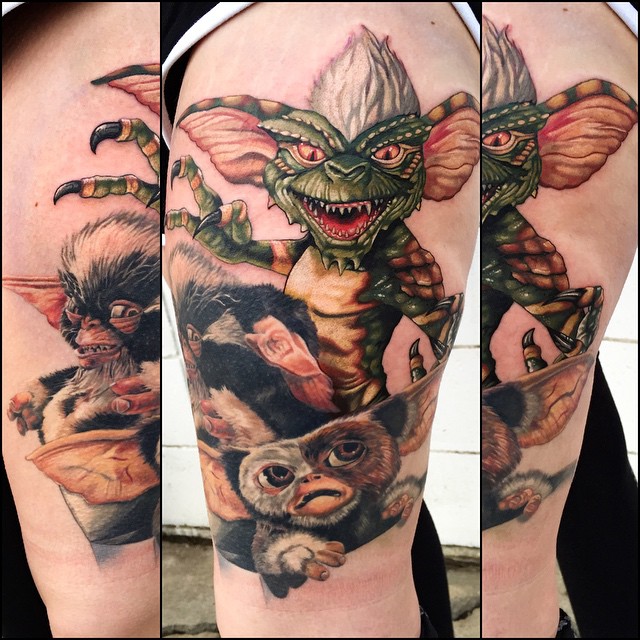Each time I scroll through my Instagram feed I see more and more available tattoo designs that have been created digitally (mainly via the iPad Pro). I wanted to explore whether there’s a future for pencil and paper in the tattoo industry. Will all tattoos eventually be drawn on tablets? Admittedly, we’ve seen computers take over many other industries and elements of our lives.

A modern convenience
As a person who gets excited by new technology, I was intrigued to see what the pros and cons of using the iPad Pro were for other artists.
“I originally moved over to the iPad because it was a lot more convenient than taking a huge gym bag’s worth of art equipment to work every day,”says tattooist Will Gee. “I can quickly get ideas out of my head and not need so much space for supplies. But I also think it’s important not to lose touch with paper and keep dabbling in that too.”
Helping save trees
When I personally decided to purchase the iPad Pro, I did so for two reasons. The first being to save my paper consumption as I’m conscious of the amount of paper I get through to create designs for my clients. Using an iPad Pro in turn saves the environment.
Easy changes
The second being that I wanted to try and save time. I find it hard to spend enough time with my family, let alone myself, and if I can find a way to work quicker and more efficiently then I’m willing to invest in those tools. Tattoo artist Becky Adelaide agreed with me:“it’s much nicer drawing on paper, but so quick and easy on the iPad – you can make changes to a client’s design without having to draw the whole thing again.”
5 benefits I found using the iPad Pro
1. Because you can layer elements (line-work, colour), you can save the image at different moments in the process and use them at a later date. Keeping the line drawing (as well as the whole finished image) saves an artist time. There’s no need to trace the completed design for the tattoo stencil (as we normally would) as the earlier lines exist as a separate file.
2. The technology is also great for cover-ups. You can draw a design right over a photo of the person’s existing tattoo.
3. You can create a video (in ProCreate) of the entire drawing process which is great for sharing the journey with followers. It gives customers a real insight into how an artist creates a tattoo design.
4. If you want to resize a selection of a design you can draw around the area and resize a particular part in seconds. On paper you’d need to scan the design onto a computer, resize the image, print it off and trace the selection onto the drawing.
5. For colouring and painting effects (like when mocking-up a watercolour design), there’s no mess or need to wait for anything to dry! For many of the artists I spoke to, the iPad Pro was great in terms of benefiting what our clients want. “For cover-ups I can mesh a few photos together to get a really good idea of size and shape needed,” tattooist Shaun Von Sleaze tells me.“Drawing it straight on the body can look a bit messy to clients so a clean precise drawing to show them beforehand is always good.”
Some of the pros I experienced
1. When the iPad and its pencil run out of battery at the same time you have to wait around for both to charge. This can be annoying if you are needing instant access to maybe alter a design for a client who is waiting for you to tattoo them.
2. The haptic feedback (i.e. touch screen technology) takes a while to get used to as the screen reacts differently to paper.
3. You need to always be prepared and stocked-up. “If you run out of printer ink suddenly, you’re screwed!” says tattooist Becky Adelaide.
4. There’s something organic about the process of actually painting with brushes for many tattooists. “I do a full hand-painted design for each tattoo because I actually love the process of painting,” watercolour tattooist Angharad Chappelle tells me. “I also often give the customer their design to keep so they can frame if they need to. I understand that the iPad does have some amazing tools for watercolour style also and will most likely try it in the future but for now it works well for me to do everything by hand.”
So – will the iPad eradicate pen and paper?
Creating art on screen is just as challenging and requires just as much skill as that created on paper. “I see a lot of comments online that using technology is cheating and not real art, that it is essentially just photocopying,” admits Shaun Von Sleaze,“but I find these complaints hard to swallow because the learning curve for jumping from paper to screen is incredibly tough.” Personally I think there are great benefits to drawing apps and tablets – they have (and will continue to) help the tattoo industry and its artists in many ways. That being said, I don’t think they will ever completely substitute drawing by hand. There is always a great skill to be learned from first learning to put paint to paper where there can arguably be less mistakes. Drawing and painting off-screen is great training and practise for tattooing skin – something in which there is no room for error. Tattooing has, and always will be, done by hand. Although modern technology can aid that process, it will never replace it.

